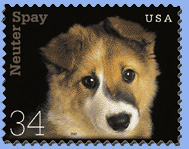|
Casey was one of the
friendliest and most energetic and playful dogs we have ever met.
Her human
was our athletic friend, Arnold. They adored each other.
Wherever Arnold went, there was Casey.
They were each other's
best friend.
The last time we saw
Casey was on the beach on the island of O'ahu in Hawai`i. She
was playfully retrieving a coconut that Arnold had flung into the
surf. A true lab, she loved the water.
We moved to California
for school soon thereafter, and the next time we saw mutual friends,
we inquired about Arnold and Casey.
That's when we found out
what happened to Casey:
On vacation, Arnold had
flown to the island of Kaua`i with Casey. It was a hot, sunny
day. Both were in peak
physical form, and Arnold and Casey took off on a two-mile day hike up and
down the ruggedly beautiful terrain to the beach at Hanakapi`ai Valley on the
Na
Pali Coast.
Before they reached the
beach, Casey began to heavily pant. She staggered, then collapsed in
a heap, semi-comatose. Dehydrated, she was suffering from heat
exhaustion, which rapidly progressed to heat stroke.
Arnold did his best to
cool her down, but the heat of the day and the humidity worked
against them. Casey closed her eyes and slipped away. Arnold administered CPR, but Casey was not
to be revived.
Devastated and in shock,
Arnold managed to hike out of the valley with Casey's body in his
arms.
In tears.

What you should
know about dog dehydration:
Staying hydrated is just as important for your dog as
it is for you. Perhaps even more so, as their body temperature is higher to
begin with, and because they're hiking with a full fur coat, dogs are often
quicker to overheat than people.
Heat exhaustion and stroke can
be fatal. It's up to you to bring a supply of clean water (drinking from ponds and streams isn't any better for your dog than it is for
you) and to make sure that your dog drinks often.
Some people teach their dogs to drink from a squirt bottle. Others bring along a
collapsible water dish. If you notice your dog running from shady spot to shady spot, panting excessively or becoming red in the
gums, stop and cool him down. Gently pouring water on the stomach and groin area is a good technique.
And don't forget that your dog needs to drink on cold days, too.
How can you tell if your dog is suffering heat-related illness?
Early signs of trouble include excessive panting and salivation, vomiting, dark red gums,
and respiratory distress.
The longer the body stays at very high temperatures the worse the prognosis becomes. Promptly
begin to cool your dog's body. Begin this emergency procedure
before you head for the vet: Spray your dog with COOL water, and place him/her
in front of a fan as soon as possible.
Ice baths are not recommended as the shivering they induce may actually slow down heat loss. Applying alcohol to the dog's feet and belly also helps
dissipate heat.
Call your vet's office ahead of time, so they are prepared to
continue the cooling efforts when you get there. Treating heat
stroke is very difficult, and many dogs do not survive.
Prevention is the key: If outside temperatures are above 80 degrees, heat illness is possible. High
humidity levels increase the risk. Prudently keep your dog inside during these times if
possible, and limit outside activities to the cooler morning and evening hours.
Back
to:
>> The Woodland Trail
>>
I  Big Bear Lake
Big Bear Lake


Click here
for lovable dogs awaiting adoption at the
Bear Mountain Dog Rescue
in Big Bear Valley.
"Adopt,
Don't Shop" ~ "Spay...Don't
Litter"
These pages are
dedicated to the memory of Laki
and the good and kind people at
Bear Mountain Dog Rescue.
I  Big Bear Lake
Big Bear Lake
|